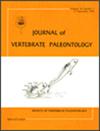Revision of the Late Miocene hornless rhinocerotids from Samos Island (Greece) with the designation of neotypes and implications for the European chilotheresCitation for this article: Kampouridis, P., Svorligkou, G., Kargopoulos, N., Spassov, N., & Böhme, M. (2023) Revision of the Late Miocene hornless rhinocerotids from Samos Island (Greece) with the designation of neotypes and implications for the European chilotheres. Journal of Vertebrate Paleontology . https://doi.org/10.1080/…
IF 1.9
4区 地球科学
Q2 PALEONTOLOGY
引用次数: 0
Abstract
Extant rhinoceroses are represented only by five species and are characterized by the presence of a nasal horn. In the past, they were much more diverse, with one of the best-known groups being the aceratheriines, i.e., hornless rhinoceroses. Chilotheres are a group of hornless rhinos that inhabited Eurasia during the Late Miocene. Their westernmost geographic range reached Eastern Europe, where overall eight species have been erected. Four of these were described based on material from the Upper Miocene of Samos Island (Greece), two of which are not considered valid anymore. Unfortunately, the type skulls of all four species are lost and there are several issues concerning their taxonomy. Therefore, we herein designate two skulls housed in historical collections from Samos as neotypes for the first two species, Chilotherium schlosseri (Weber, 1905) and Eochilotherium samium (Weber, 1905), and provide detailed comparisons for the separation of the species from each other and from any other chilotheres. Our results prove that the two species are valid and justify their separation on a generic level. Chilotherium schlosseri seems to be more closely affiliated with the other European Chilotherium species, whereas E. samium is more similar to the Chinese ‘Chilotherium’ wimani and ‘Chilotherium’ primigenium, based on their more plesiomorphic characters.希腊萨莫斯岛(Samos Island)晚中新世无角犀类的新类型命名及其对欧洲儿童的启示。本文引用本文:Kampouridis, P., Svorligkou, G., Kargopoulos, N., Spassov, N., &;Böhme, M.(2023)希腊Samos岛晚中新世无角犀类的新类型划分及其对欧洲chilotheres的启示。古脊椎动物杂志。https://doi.org/10.1080/..。
现存的犀牛只有五个物种,它们的特征是有一个鼻角。在过去,它们的种类要多样得多,其中最著名的一种是无角犀牛,即无角犀牛。Chilotheres是一群在中新世晚期居住在欧亚大陆的无角犀牛。它们最西端的地理范围到达了东欧,在那里总共竖立了8种。其中四个是根据Samos岛(希腊)上中新世的材料描述的,其中两个被认为不再有效。不幸的是,这四个物种的头骨类型都丢失了,而且它们的分类学存在一些问题。因此,我们在此将萨摩斯历史藏品中的两个头骨指定为前两个物种的新类型,即Chilotherium schlosseri (Weber, 1905)和Eochilotherium samium (Weber, 1905),并对这两个物种之间以及与任何其他chilotheri之间的分离进行了详细的比较。我们的结果证明了这两个物种是有效的,并证明了它们在一般水平上的分离。Chilotherium schlosseri似乎与其他欧洲Chilotherium物种更接近,而E. samium则更接近中国的“Chilotherium”wimani和“Chilotherium”primigenium,基于它们更多的半形特征。
本文章由计算机程序翻译,如有差异,请以英文原文为准。
求助全文
约1分钟内获得全文
求助全文
来源期刊
CiteScore
2.90
自引率
7.10%
发文量
58
审稿时长
4-8 weeks
期刊介绍:
The Journal of Vertebrate Paleontology publishes original contributions on all aspects of vertebrate paleobiology, including vertebrate origins, evolution, functional morphology, taxonomy, biostratigraphy, phylogenetics, paleoecology, paleobiogeography, and paleoanthropology. JVP publishes high quality peer-reviewed original articles, occasional reviews, and interdisciplinary papers. It is international in scope, and emphasizes both specimen- and field-based based research and the use of high-quality illustrations. Priority is given to articles dealing with topics of broad interest to the entire vertebrate paleontology community and to high-impact specialist studies. Articles dealing with narrower topics, including notes on taxonomic name changes (unless these deal with errors published in JVP), preliminary site reports, and documentation of new specimens of well-known taxa, are afforded lower priority.

 求助内容:
求助内容: 应助结果提醒方式:
应助结果提醒方式:


